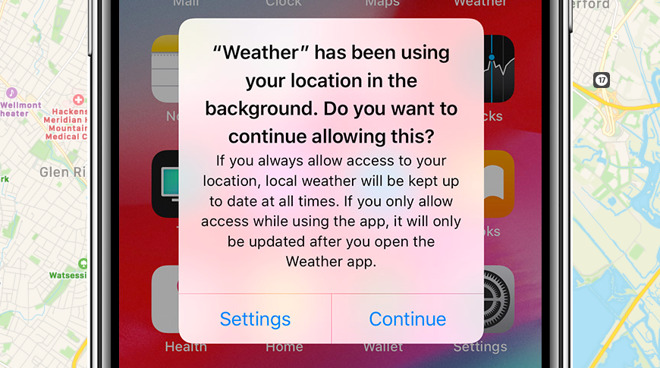Apple's initiatives to minimize tracking by marketers is continuing to make life harder for the advertising industry, forcing advertisers to use inefficient data sources to pinpoint users.

Over the years, Apple has enhanced how it protects the privacy of its users online, typically by limiting what data can be seen by advertisers tracking different data points. Initiatives such as Intelligent Tracking Protection in Safari has helped secure more privacy by making it harder to track individual users, which advertising executives in December admitted has been "stunningly effective."
While ITP and other improvements have helped to minimize the tracking of users, marketers are also being affected by another element of iOS 13, one where users are regularly notified of apps that are capturing their location in the background. The warning gives options for users to allow an app to continue to track all the time or to do so when it is open, with users often selecting the latter.
According to data from location-verification firm Location Sciences seen by DigiDay, approximately seven in ten iPhone users analyzed by the company downloaded iOS 13 in its first six weeks of availability. Of those users who installed the update, around 80% of them stopped all background tracking by apps.
Ad tracking company Teemo suggests the opt-in rates to share data with apps when not in use are often below 50%, whereas three years ago, the same rates were close to 100%. The higher rates were due to it being a time when users were largely unaware there were options to disable tracking in the first place.
"People have decided to stop their phones' sharing location data at a universal level," Location Sciences chief business officer Jason Smith admitted.
The trend of disabling tracking makes it harder for firms to rate the effectiveness of campaigns, Starcom managing partner Paul Kasamias suggests. The change impacts "the ability to tie users that research online and purchase in store," as well as making measuring footfall in stores a "far more opaque" process for clients.
A drop in advertiser spending is likely to occur from small or medium-sized advertisers, Kasamias believes, as they are clients "where cost efficiency is paramount and there is a physical footprint, as targeting the right user at the right time will become more difficult."
The change has already led to a reduction in "sales pitches from providers of location-data solutions," Havas Media EVP Sargi Mann claimed, with there being more of a need to address the location issue "transparently up front as part of bigger deals" with marketers.
Despite the reduced amount of location data available, the amount that is still available to use is more valuable, while the market for location data continues to thrive.
"We're still being approached by location data businesses that are telling us they're growing, said Rippll CEO Doug Chisholm. "More importantly, they have more data than they did a year ago."
The quality of that data is still a problem, as ad buyers notice it is of a lower quality than data that was previously available. According to Smith, Location Sciences is seeing less location data derived from a smartphone's GPS, "which is the most precise source of mobile location data."
Instead, Smith highlights the presence of "lower quality data" sourced from carriers or other Internet protocols. "Often the least accurate sources of mobile location data available" to a marketer in his opinion.
The reduction of available data may get worse for marketers, as Apple has urged developers to use "Sign in with Apple" in apps, as an alternative to authentication systems offered by Google and Facebook. While Apple's system will make it harder to track individual users with less data offered to firms, data collection will still be possible for the firms involved.



